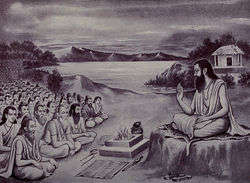Naimisha: Unterschied zwischen den Versionen
Aus Yogawiki
Keine Bearbeitungszusammenfassung |
Keine Bearbeitungszusammenfassung |
||
| Zeile 16: | Zeile 16: | ||
== Literatur == | == Literatur == | ||
*Dowson, John: A Classical Dictionary of Hindu Mythology and Religion – Geography, History and Religion; D.K.Printworld Ltd., New Delhi, India, 2005 | *Dowson, John: A Classical Dictionary of Hindu Mythology and Religion – Geography, History and Religion; D.K.Printworld Ltd., New Delhi, India, 2005 | ||
*[http://www.yoga-vidya.de/Yoga--Buch/Upanischaden/Chandogya3.htm Klassische Upanishaden - Die Weisheit des Yoga - Die Chandogya-Upanishad des Samaveda] | |||
==Seminare== | ==Seminare== | ||
Version vom 27. Juni 2014, 20:16 Uhr
Naimisha, Naimisharanya: Ein Wald (Aranya) in der Nähe des Gomati (Gumti) Flusses. Hier wurde das Mahabharata von Sauti den versammelten Rishis vorgeführt.

Sauti erzählt das Mahabharata den versammelten Weisen im Naimisha Wald.
Siehe auch
- Shaunaka
- Bhagavata Purana
- Adi Parva
- Uttara Gita
- Ugrashravas
- Brahma Vaivarta Purana
- Brahmanda Purana
- Brihaddharma Purana
- Sauti
Literatur
- Dowson, John: A Classical Dictionary of Hindu Mythology and Religion – Geography, History and Religion; D.K.Printworld Ltd., New Delhi, India, 2005
- Klassische Upanishaden - Die Weisheit des Yoga - Die Chandogya-Upanishad des Samaveda
Seminare
Der RSS-Feed von https://www.yoga-vidya.de/seminare/interessengebiet/indische-schriften/?type=2365 konnte nicht geladen werden: Fehler beim Parsen von XML für RSS